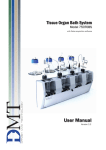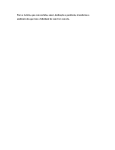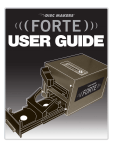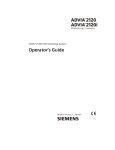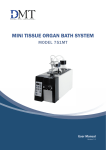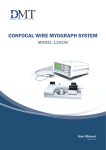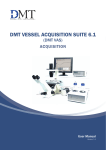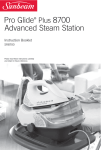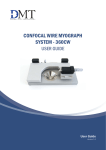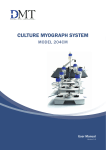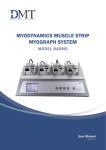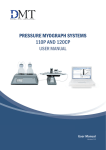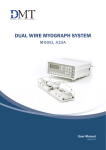Download User Manual 750TOBS
Transcript
TISSUE ORGAN BATH SYSTEM MODEL 750TOBS User Manual Version 2.5 1 2 TISSUE ORGAN BATH SYSTEM - MODEL 750TOBS USER MANUAL TISSUE ORGAN BATH SYSTEM MODEL 750TOBS TRADEMARKS PowerLab® and LabChart® are registered trademarks of ADInstruments Pty Ltd. The names of specific recording units, such as PowerLab 4/25, are trademarks of ADInstruments Pty Ltd. Pentium is a registered trademark of the Intel Corporation. Windows, Windows 95, Windows 98, Windows ME, Windows NT, Windows 2000 and Windows XP are registered trademarks of Microsoft Corporation. All other trademarks are the properties of their respective owners. DMT reserves the right to alter specifications as required. This document was, as far as possible, accurate at the time of printing. Changes may have been made to the software and hardware it describes since then. New information may be supplied separately. This documentation is provided with the DMT Tissue Organ Bath System – Model 750TOBS All rights reserved. No part of this manual may be reproduced or transmitted in any form or by any means without the written permission of Danish Myo Technology A/S. Every attempt is made to ensure accurate information, misprints, construction- and specification changes can occur. Danish Myo Technology A/S reserves the right to alter/change content as required and without any notice. Copyright © Danish Myo Technology A/S TRADEMARKS 3 CONTENTS Trademarks.........................................................................................................................................................................................3 Introduction........................................................................................................................................................................................5 Safety..................................................................................................................................................................................................6 EMC / EMI..........................................................................................................................................................................................7 Approvals............................................................................................................................................................................................7 Certificate of Conformity...................................................................................................................................................................8 About this manual.............................................................................................................................................................................9 Unpacking the Tissue Organ Bath System................................................................................................................................... 10 Chapter 1 - System overview......................................................................................................................................................... 11 1.1 Tissue Organ Bath System - front panel........................................................................................................................................ 11 1.2 Tissue Organ Bath System - rear panel....................................................................................................................................... 12 1.3 Tissue Organ Bath unit................................................................................................................................................................... 13 Chapter 2 - Setting-up.................................................................................................................................................................... 14 2.1 The Complete Tissue Organ Bath System - 750TOBS ................................................................................................................. 14 2.2 Setting up step-by-step ................................................................................................................................................................. 14 Chapter 3 - User software.............................................................................................................................................................. 15 3.1 The Software program.................................................................................................................................................................... 15 3.2 The 750TOBS-software User Interface......................................................................................................................................... 15 Chapter 4 - The Tissue Organ Bath unit........................................................................................................................................ 34 4.1 The first weight calibration............................................................................................................................................................. 34 4.2 Tissue chamber handling.............................................................................................................................................................. 35 4.4 Mounting supports......................................................................................................................................................................... 37 4.5 Tissue Organ Bath System - 750TOBS maintenance................................................................................................................... 38 4.6 Tissue Organ Bath System - 750TOBS cleaning.......................................................................................................................... 38 Appendix 1 - Fuse replacement..................................................................................................................................................... 39 Appendix 2 - Software installation ............................................................................................................................................... 40 Appendix 3 - VCP – Driver installation.......................................................................................................................................... 42 Appendix 4 - Buffer recipes........................................................................................................................................................... 44 Appendix 5 - 750TOBS controller...................................................................................................................................................47 Appendix 6 - System Specifications ............................................................................................................................................. 56 Notes.................................................................................................................................................................................................57 4 TISSUE ORGAN BATH SYSTEM - MODEL 750TOBS USER MANUAL INTRODUCTION The vertical organ bath with its double walled glass chamber is the traditional experimental setup that has been used extensively to investigate the physiology and pharmacology of smooth muscle (vascular and non-vascular) and other tissue preparations, through measurement of contractile force while bathed in an appropriate physiological solution or buffer at 37oC. The advantages in these studies is that the preparation can be subjected to pharmacological agents while excluding the influence of systemic processes that occur in intact animals. The results of these organ bath systems are generally more consistent, reproducible and lend themselves for screening and the measurement of concentration response curves (CRCs) The most common application of the organ bath assay are in cardiovascular research, using isolated aorta rings, heart tissue (papillary muscle) or arteries. In studying gastro-intestinal effects, preparations of ileum and colon are often used, but also gastric antral muscle and sphincter may be studied. Respiratory effects can be studied in isolated tracheal rings, phrenic diaphragm preparations, pulmonary arterial smooth muscle and even lung parenchyma. Other smooth muscle preparations that are used in organ bath research are urinary bladder, penile (corpus cavernosum) muscle strips and prostate. Because of these inherent qualities and the versatility in use, the basic organ bath design has seen little change over the last few decades. Nonetheless, there are some practical drawbacks e.g. they take much bench space, use circulating water by causing temperature delays and gradients, are tough to clean, hard to automate, and non GLP compliant. To remedy these limitations DMT has now redesigned the organ bath system for the new millennium using the latest developments in material, computer and tissue engineering. We took away the heating by water, replaced it by very fast air heating, made the chambers disposable or reusable after cleaning, added automated control of filling, emptying and gassing by an embedded microprocessor and provide digital output of force and complete computer control of the instrument. All of this in a box that takes up a quarter of the space of a traditional system. The modular design allows up to four individually mounted tissues to be studied simultaneously and independently per system. Moreover, multiple systems can be linked together (USB connection) for high throughput screening (HTS) and up to 16 units can easily be run by a single person. The convenient compact bench-top design of the DMT’s organ bath system can be placed in any existing laboratory environment while gaining back valuable bench top space. INTRODUCTION 5 SAFETY DMT Tissue Organ Bath System - 750TOBS has been designed for use only in teaching and research applications. It is not intended for clinical or critical life-care use and should never be used for these purposes: nor for the prevention, diagnosis, curing, treatment, or alleviation of disease, injury, or handicap. • Do not open the unit: the internal electronics pose a risk of electric shock. • Do not use this apparatus near water. • T o reduce the risk of fire or electric shock, do not expose this apparatus to rain or moisture. Objects filled with open liquids should not be placed on the apparatus. • Do not block any ventilation openings. Install in accordance with the manufacturer’s instructions. • O nly use secure industry standard connectors and tubing for pressure and vacuum connections. Faults, defects and mistakes due to wrong connections void warranty. We are not accountable for results and mistakes due to inappropriate pressure or vacuum hookup. • Do not install near any heat sources such as radiators, heat registers, stoves, or other apparatus that produce heat. • Only use attachments and accessories specified by the manufacturer. • Unplug this apparatus during lightning storms or when unused for long periods of time. • This apparatus must be grounded. • Use a three-wire grounding-type cord similar to the one supplied with the product. • D o not defeat the safety purpose of the polarized or grounding-type plug. A polarized plug has two flat blades, one being wider than the other. A grounding type plug has two blades and a third (round) grounding pin. The wide blade or the third prong is provided for your safety. If the provided plug does not fit into your outlet, consult an electrician for replacement of the obsolete outlet. • B e advised that different operating voltages require the use of different types of line cord and attachment plugs. Check the voltage in your area and use the correct type. See the table below: Voltage Line plug according to standard 110–125 V UL817 and CSA C22.2 No. 42 220–230 V CEE 7 page VII, SR section 107-2-D1/IEC 83, page C4. 240 V BS 1363 of 1984. Specification for 13A fused plugs and switched and unswitched socket outlets. Protect the power cord from being walked on or pinched: particularly at power plugs and the point where they connect to the apparatus. Refer all servicing to qualified service personnel. Servicing is required when the apparatus has been damaged in any way; such as, the power-supply cord or plug is damaged, liquid has spilled onto or objects have fallen into the apparatus, the apparatus has been exposed to rain or moisture, does not operate normally, or has been dropped. 6 TISSUE ORGAN BATH SYSTEM - MODEL 750TOBS USER MANUAL EMC / EMI This equipment has been tested and found to comply with the limits for a Class B Digital device, pursuant to part 15 of the FCC rules. These limits are designed to provide reasonable protection against harmful interference in residential installations. This equipment generates, uses and can radiate radio frequency energy and, if not installed and used in accordance with the instructions, may cause harmful interference to radio communications. However, there is no guarantee that interference will not occur in a particular installation. If this equipment does cause harmful interference to radio or television reception (which can be determined by monitoring the interference while turning the equipment off and on), the user is encouraged to correct the interference by one or more of the following measures: • Reorient or relocate the receiving antenna. • Increase the separation between the equipment and receiver. • Connect the equipment into an outlet on a circuit different to that which the receiver is connected to. • Consult the dealer or an experienced radio/TV technician for help. APPROVALS Complies with the EMC standards: EMC 89/336/EEC: EN 61326-2-6:2005 EN 61000-3-2. Certified with the safety standards: Directive 2006/95/EC: EN 61010-1:2001 EN 61010-1/Corr.1:2003 EN 61010-1/Corr.1:2003 EN 61010-2-101:2003 EMC/EMI 7 CERTIFICATE OF CONFORMITY DMT A/S, Skejbyparken 152, 8200 Aarhus N., Denmark, hereby declares its responsibility that the following product: DMT Tissue Organ Bath System – Model 750TOBS is covered by this certificate and marked with CE-label conforms with the following standards: EN 61010-1:2001 EN61010-1/Corr.1:2003 EN 61010-1/Corr.1:2003 Safety requirements for electrical equipment for measurement, control, and laboratory use Part 1: General requirements. EN 61010-2-101:2003 Safety requirements for electrical equipment for measurement, control and laboratory use - Part 2-101: Particular requirements for in vitro diagnostic (IVD) medical equipment. EN 61326-2-6:2005 Electrical equipment for measurement, control and laboratory use EMC requirements - Part 2-6: Particular requirements - In vitro diagnostic (IVD) medical equipment. With reference to regulations in the following directives: 2006/95/EC, 89/336/EEC 8 TISSUE ORGAN BATH SYSTEM - MODEL 750TOBS USER MANUAL ABOUT THIS MANUAL This manual contains a complete list of procedures describing how to install, maintain and get started using the Tissue Organ Bath System - 750TOBS. Chapter 1 provides an overview of the construction and basic features of the Tissue Organ Bath System - 750TOBS. Chapter 2 describes step-by-step how to setup a complete Tissue Organ Bath System - 750TOBS including accessories. Chapter 3 is a complete manual to the Interface. The chapter describes in detail the construction of the software and how to use all the features of the Tissue Organ Bath System - 750TOBS. Chapter 4 is a description of everyday handling of Tissue Organ Bath System - 750TOBS and the different kinds of mounting views available. It also contains procedures describing general as well as daily maintenance of the Tissue Organ Bath unit; e.g. weight calibration of the force transducers and cleaning instructions. Appendices contain various additional information about Software installation, Buffer recipes, System specifications and Fuse replacement. ABOUT THIS MANUAL 9 UNPACKING THE TISSUE ORGAN BATH SYSTEM Please take a few minutes to carefully inspect your new Tissue Organ Bath System - 750TOBS for damage, which may have occurred during handling and shipping. If you suspect any kind of damage, please contact us immediately and we will take care of the problems as quickly as possible. If the packing material appears damaged, please retain it until a possible claim has been settled. We recommend that you store the packing material for any possible future transport of the Tissue Organ Bath System - 750TOBS. In case of transport and the original packing material is unavailable, please contact DMT Sales Department for advice and packing instructions. After unpacking your new Tissue Organ Bath System - 750TOBS, please use the following list to check that the system is complete: • 1 x Tissue Organ Bath Unit • 4 x Chamber units (20 ml) • 4 x 1000ml Schott Duran Bottles incl. special designed screw caps • 4 x Mounting supports, triangle hooks • 1 x Tube Kit • 1 x Calibration Kit (including marked tissue bath (20 ml) and 5 gram weight) • 1 x USB cable • 1 x Power cord* • 5 meter cable air + clamps • 2 x 7 mm fasteners • Grease • 1 CD with user manual for Tussie Urgan Bath Systems • PC Acquisition software * The shape of the AC plug varies by country; be sure that the plug has the right shape for your location 10 TISSUE ORGAN BATH SYSTEM - MODEL 750TOBS USER MANUAL CHAPTER 1 - SYSTEM OVERVIEW 1.1 Tissue Organ Bath System - front panel Mounted to the lid inside the bottles: A constant flow shunt or a fill/empty shunt Micrometer positioner Perfusion buffer inlet Transducer Tissue chamber Power indicator Sample holder Oxygenation/CO2regulator Chamber door Glass presenec indicator Figure 1.1 Tissue Organ Bath System - front panel CHAPTER 1 11 1.2 Tissue Organ Bath System - rear panel Communication indicator 115-230V/50-60Hz automatic voltage selector USB connection ON/OFF switch Analogue recorder output Power connector Suction connection for vacuum pump Pressure inlet, max 10bar/145psi Figure 1.2 Tissue Organ Bath System rear panel 12 TISSUE ORGAN BATH SYSTEM - MODEL 750TOBS USER MANUAL 1.3 Tissue Organ Bath unit Chamber detector Tissue chamber Air heating Sample holder (lower part shown) Figure 1.3 Tissue Organ Bath unit NOTE: THE CHAMBER DETECTOR REGISTERS WHEN THE TISSUE CHAMBER IS PLACED. IF THE CHAMBER IS PLACED CORRECTLY THE BLUE INDICATOR LAMP WILL BE LIT AND THE TISSUE ORGAN BATH WILL WORK. Knob for dismounting chamberdisc and temperature probe Glass indicator On: Glass mounted Off: Glass removed Oxygenation /CO2 regulator Temperature probe Oxygenation /CO2 tubing/pipe Suction tube/pipe Perfusion buffer inlet Figure 1.3a Tissue Organ Bath unit NOTE: REGARDING THE OXYGENATION/CO2 REGULATOR: THE REGULATORS NEED TO BE GREASED AT LEAST TWICE A YEAR. ALSO MAKE SURE THAT THE REGULATORS ARE TURNED AT REGULAR INTERVALS TO PREVENT THEM FROM GETTING STUCK. USE THE GREASE THAT CAME WITH THE SYSTEM. CHAPTER 1 13 CHAPTER 2 - SETTING-UP 2.1 The Complete Tissue Organ Bath System - 750TOBS CS200 Current stimulator (optional) Organ Bath rear panel Connection to O2/CO2 supply Power supply Vacuum pump (optional) USB connection O2 Suction bottle (optional) Organ Bath front panel PC data acquisition & software Figure 2.1 Complete Tissue Organ Bath System 2.2 Setting up step-by-step 1. Oxygen/CO2 supply: The oxygen/CO2 supply is attached to the pressure inlet on the back of the organ bath. After connecting the main gas supply the regulators can adjust the inlet into each chamber. Turning the regulator clockwise increases the oxygen/CO2 supply, turning it counter clockwise decreases it. Pressure inlet: Min. 2 bar (200 kPa, 29 PSI) Max 8 bar (800 kPa, 116 PSI) 2. Suction connection: The system has built-in suction manifold with separate valves that allows each chamber to be drained individually. After connecting your suction device to the outlet on the back of the Tissue organ bath, all chambers or an appropriate chamber will be drained by activating the Fill & Empty Control (see “3.2.2 The Main window” on page 16) When using a vacuum pump use around 11 L/min NOTE: PLEASE BE AWARE OF LOCAL REGULATIONS AND CODES FOR HOOKUP TO (HOUSE) VACUUM SYSTEMS. A VACUSHIELD IS RECOMMENDED AND LOCAL REGULATIONS MAY REQUIRE SHIELDED NON-GLASS (NALGENE) BOTTLES AND RESERVOIRS TO BE USED TO COLLECT WASTE. NOTE: WHEN DRAINING THE CHAMBERS USING THE AUTOMATIC SUCTION FUNCTION, PLEASE PRESS THE APPROPRIATE FILL & EMPTY CONTROL FOR AN ADDITIONAL 3-5 SEC. AFTER THE CHAMBER APPEARS TO BE EMPTY. THIS WILL PREVENT “LEFTOVERS” FROM USED SOLUTIONS BEING RETAINED IN THE TUBING AND VALVES. 14 TISSUE ORGAN BATH SYSTEM - MODEL 750TOBS USER MANUAL CHAPTER 3 - USER SOFTWARE Chapter 3 is a complete manual for the Tissue Organ Bath System Data Acquisition software. The chapter contains a step-by-step description of how to navigate in the software and how to use the special features of the Tissue Organ Bath System. If the user only wishes to use the 750TOBS Controller program please see “Appendix 5 - 750TOBS controller” on page 47. A software installation guide can be found in the Appendix. 3.1 The Software program The 750TOBS-Software is generic to the Tissue Organ Bath application and gives the software a particular flexibility which users may find helpful in organizing their work. The software is used to control and acquire data from the 750TOBS. The 750TOBS-Software provides many ways of displaying data: • • • • The grid and the colors of the dataview are changeable. The windows can be resized Expanding or contracting the X- and Y-axis can be done to meet the needs of the user Showing all four channels or just one channel. There are three tabs: 1. The dataview tab, showing the data collected from the four force transducers. 2. The comments tab showing a log of all user actions done on the four chambers. 3. The Data Pad tab, showing user chosen data from the dataview. The acquired data, comments and the Data Pad, can be exported to an Excel Worksheet for further processing. 3.2 The 750TOBS-software User Interface The first time the 750TOBS is turned on, the VCP drivers must be installed as described in “Appendix 3 - VCP – Driver installation” on page 42. 3.2.1 Connect to 750TOBS Setup->Connect to 750TOBS: The connection to the 750TOBS is automatic. When the connection is performed, the message “Connected: COMx” is displayed in the status bar in the bottom left corner of the program window. If the connection fails, the message display is: “Not connected”. In case the connection fails try connecting by clicking on ‘Setup->Connect’. If the connection fails again, check if the USB cable is mounted correctly and 750TOBS is turned on. If two 750TOBS are connected to one PC use both programs. Always connect 750TOBS-Software A before 750TOBS-Software B. CHAPTER 3 15 3.2.2 The Main window Data view tab Drop down menus Dataview toolbar Chamber controls Statusbar Visible data All data Activate an axis by left clicking on it. The activated axis is marked by a black rectangle. The axis can now be scrolled or zoomed using the scroll or zoom tool. Arrow keys, PageUp, PageDown, Home and End buttons can also be used on an active axis. Figure 3.1 The Tissue organ bath User Interface DataView toolbar X View all Resume to the end of the datasheet X+ Increase X axis Scroll X Decrease X axis Zoom Y View all Select: Activate to select comments in the dataview. To Y Increase Y axis view a comment hold the cursor above a comment line, Y+ Decrease Y axis left click and a new window will open showing data from - - Go to the beginning of the file Go to the beginning, one page at a time Go to the beginning, 1/10 page at a time Go to the end of the file Go to the end, one page at a time Go to the end 1/10 page at a time Undo up to the last 10 zoom actions Start/Stop recording Choose sample rate 16 TISSUE ORGAN BATH SYSTEM - MODEL 750TOBS USER MANUAL the selected comment. Cursor: The cursor is moved by holding the left mouse button while moving the mouse. There are several options for reading data. Right clicking on the cursor opens an options menu. Full screen Upper half (when 2 programs are open at the same time) Lower half (when 2 programs are open at the same time) Zoom selection of data in the Data view: An easy way of selecting data in the Data View is by dragging the mouse over the area while holding down the Alt key (X-axis) and the left mouse button or the shift key (Y-axis in the one channel view only) or the Alt+shift (X- and Y-axis in the one channel view only). Zoom in on the X-axis: Four and one channel view Alt + left mouse button Zoom in on the Y-axis: One channel view only Shift + left mouse button Zoom in on the X-axis and Y-axis: One channel view only Alt+Shift +left mouse button CHAPTER 3 17 Tissue chambers controls Empty chamber Fill chamber Pressure is activated/deactivated by clicking the ‘off’ button below or on the progress bar. If Auto is checked, the chamber is filled up with the programmed amount of ml. Otherwise the chamber is filled until the ‘fill up’ button is clicked again. Red: The pressure is off. Blue: The pressure is on Zero force Green: The chamber is in place. Red: The chamber is missing or not positioned correctly. If All is checked, the activation of ‘Fill’, ‘Empty’, ‘Zero’, ‘Pressure’ and ‘Fill of chamber 1’ will be applied to all the chambers. 18 TISSUE ORGAN BATH SYSTEM - MODEL 750TOBS USER MANUAL When the reservoir bottles are refilled or filled for the first time, write the volume in the bottle in the window that pops-up: 3.2.3 Drop down menus 3.2.3.1 File menu New: Create a new file to begin a Data acquisition Open: Open an exciting file Save: Save the file Save Data view to file: Several image formats are supported for saving static images of the Data view. This is useful for exporting the image for use in an external reporting tool, or for other uses where a “snapshot” of the chart is needed. Supported image formats are: • • • • Enhanced Metafile Format (EMF) Windows Bitmap (BMP, RGB Encoded) Independent JPEG Group Format (JPEG, JPG) Portable Network Graphics Format (PNG, 16 million colors) Export Data file to Excel worksheet See section 3.6.3 Export Data pad to Excel worksheet See section 3.6.2. Export Data view to clipboard Same as Save Data view to file, except that the image is placed in the clipboard, and can be imported in any program using the paste command CTRL+V. Print->Print Data view: Prints the Data view on the default printer. Print->Print comments: Prints the comments on the default printer. Print->Print Data pad: Prints the Data pad on the default printer. Auto backup Opens a new window where auto Backup is set. CHAPTER 3 19 3.2.3.2 Setup menu Force units: Choose between mN or gram Connect to 750TOBS: Connect or disconnect the 750TOBS 750TOBS parameters: See sections 3.2.3.3 to 3.2.3.12 User Interface: There are two choices: 1. Controller (described in Appendix 5. It is used when another software package is used for acquisition.) 2. Acquisition & Controller. Chambers: The window can also appear by double clicking on the Y-axis. Axis and Grid: The window can also appear by double clicking on the X-axis. Y-axis’ color Y-axis setting X-axis’ color Change the settings for ‘Set. Temp’. and ‘Volume’ in a choosen chamber. If ‘All’ is checked, the changes will be applied to all four chambers. (In Constant Wash Mode, the Volume setting is changed to Flow, and units to ml/min) X-axis setting Comments setup: Up to 20 default comments can be saved. The window can also appear by double clicking on the ‘Comments input field’. 20 TISSUE ORGAN BATH SYSTEM - MODEL 750TOBS USER MANUAL 3.2.3.3 Fill/Empty calibration Setup->750TOBS parameters ->Fill/Empty calibration The amount of fluid filling the tissue chamber is time regulated. Calibration of each chamber is performed with the marked tissue chamber provided with the calibration kit (20 ml). Adjust the numbers of each tissue chamber until the amount of fluid is correct, the numbers indicates msec/ml. If the amount of fluid is to small, the number (msec/ml) must be higher. If the amount of fluid is to high the number (msec/ ml) must be lower. 3.2.3.4 Pressure Setup->750TOBS parameters->Pressure Adjustment and on-line reading of pressure. This setting is normally NOT changed. Actual pressure ‘Act. Pressure’ provides an on-line reading of the actual pressure in the reservoir bottles. Set pressure To set or reset the target pressure (0.01- 0.999 Bar). (Default: 0.400) Update ‘Update’ provides an on-line reading of the actual pressure. NOTE: WHEN THE PRESSURE IS RESET PRESS THE SMALL BUTTON THAT APPEARS TO THE RIGHT OF THE SET PRESSURE INPUT FIELD. IF THE PRESSURE IS CHANGED, THE FLOW MUST BE CALIBRATED AGAIN, AS DESCRIBED IN PARAGRAPH 3.2.3.10 3.2.3.5 Heating plate temperature Setup->750TOBS parameters->Heating plate temperature Adjusts the temperature on the heating plate, on which the reservoir bottles are placed. The temperature here is chosen to be higher than the bath temperature to avoid gas formation in the lines and to correct for cooling during refilling of the chambers. ‘Set Temperature’ is used to set the set temperature of the heating plate for the reservoir bottles. (Default: 39°C). The Set Temp. is updated when clicking the OK button. NOTE: TO MINIMIZE THE HEATING TIME ONE CAN BENEFIT BY PRE-HEATING THE BUFFER TO 35°C BEFORE FILLING THE RESERVOIR BOTTLES FOR THE FIRST TIME IN THE DAY. CHAPTER 3 21 3.2.3.6 Temperature difference Setup ->750TOBS parameters->Temperature difference Adjustment between the actual temperature and target temperature. The Set temperature and Actual temperature may not be equal due to the ambient temperature in the lab. It is possible to compensate this with this setting. Example: If the Set.Temp for Chamber 1 is 37.0°C and the actual temperature measured in Chamber 1 is 36.2°C . The Difference Setting for Chamber 1 must be 0.8. 3.2.3.7 Analog output Setup ->750TOBS parameters-> Analog output The output is from 0.0 to 2.5 Volt. (Resolution is 0.61 mV). In this window the span can be adjusted. In the example above the span is set to 110 mN . The output is 0.0 Volt, if the force is -10 mN and 2.5 Volt if the force is 100 mN. The internal sample frequency is 20 Hz on each channel. Any digital filtering in your data acquisition software, must be set above 20 Hz. If the setting Direct output is choosen the settings above is not used. The output is then routed directly from the transducer : Offset: 2.5 Volt Output: +/-300µV/mN If Direct output is used the signal is not filtered and the output is only limited by the transducers response time, it is approximately 10 mS. 3.2.3.8 Weight calibration data Setup ->750TOBS parameters->Weight calibration data A read out of the Force calibration data. (Only for internal use, if there are some problems with a transducer). 22 TISSUE ORGAN BATH SYSTEM - MODEL 750TOBS USER MANUAL 3.2.3.9 Wash Setup ->750TOBS parameters ->Wash Programming of the wash sequence. The wash sequence works by overflow. In the example to the right the wash sequence is set to: Wash 4 sec. every 1 min. 2 times, then wash 3 sec. every 1 min. 5 times. If ‘next wash’ is not checked, there will only be one wash 3.2.3.10 Flow calibration Setup ->750TOBS parameters->Flow calibration Before this calibration is performed, the low flow shunt supplied in the calibration kit must be mounted on the tubing inside the reservoir bottle. Calibration of flow in Constant Wash mode is performed by the marked Tissue chamber provided with the calibration kit (5ml), (Optional for the 750TOBS, please contact DMT for purchase). On the Tissue chamber there are two marks used for the calibration. The calibration is done one chamber at the time. 1. Turn off oxygenation. 2. Choose the chamber to calibrate. Click Start flow. 3. When the surface of the fluid reaches the bottom mark on the calibration tissue chamber, click the Start Measure button. Check this by looking at the line at eye level and look for the bottom of the fluid meniscus to reach the line! 4. When the surface of the fluid reaches the top mark on the calibration tissue chamber, click the Stop Measure button. 5. Click the OK button. Flow calibration for the chosen chamber is now finished. Repeat step 1-5 for all the chambers. 5ml 0ml 5ml 0ml CHAPTER 3 23 3.2.3.11 Mode select Setup ->750TOBS parameters-> mode -> The 750TOBS has two different wash modes. Constant wash and Fill/empty. The classic way of changing solution in an organ bath system is to drain the entire bath and refilling it with fresh buffer via a Fill/ empty routine. The advantage of this method is that the concentration of drug declining fast especially if this is repeated 3 times or more. The 750TOBS can do this automatically via the wash menu and the buffer comes from the pre-heated buffer reservoir in the system. Therefore compared to the classic approach, washing is easy, convenient and fast. A disadvantage of this fill/ empty method is that the tissue is briefly suspended in air, without nutrients and stimulation, when used, needs to be suspended. When the fill/empty mode is selected go to Setup->Chamber 1-4 or double click on the chamber’s y-axis to adjust the settings. A second new method in the 750TOBS is to perform a constant wash at a preset flow rate. In the 750TOBS the fresh warm buffer from the reservoir is filled from below and excess buffer is evacuated from the overflow on the top. The flow rate can be programmed from 0.5 - 5.0 ml/min. Although it may take a little more time to completely wash any drugs away, the advantages are that the tissue is never in air, stays in warm buffer and stimulation, if used, does not need to be interrupted. The user is encouraged to try both methods and based on own judgment determine what is best for the experimental conditions. When the Constant wash mode is selected go to Setup->Chamber 1-4 or double click on the chamber’s y-axis to adjust the settings. IMPORTANT: WHEN THE MODE IS CHANGED, THE SHUNT INSIDE THE BOTTLE MUST BE CHANGED TOO. 24 TISSUE ORGAN BATH SYSTEM - MODEL 750TOBS USER MANUAL The Constant wash mode requires the Constant flow shunt and Fill/Empty mode requires the Fill/Empty flow shunt. IMPORTANT: MAKE SURE THAT THE PRESSURE IS OFF BEFORE CHANGING THE SHUNTS. A warning noting that the pressure is turned off, is shown when the mode is changed. Constant flow shunt (Hypodermic needle 0,4 x 40mm) Fill/Empty flow shunt Accessories, please contact DMT for purchase CHAPTER 3 25 3.2.3.12 Weight calibration By activating Setup ->750TOBS parameters-> Calibrate transducers -> Chamber X a message appears as shown to the right. Place the 5g weight on the transducer. Wait until the relative force reading is stable. Click OK. The force applied on the force transducer should mimic the stretch created by the contraction of a mounted ring preparation. 3.3.1 View The Dataview can be set to display all four channels or one single channel. Enable ‘comments’ to see where comments have been added. See Paragraph 3.2.3.2. Double click Double click Double click Double clicking on the channel will also result in shifting between one or four channels Double clicking on the Force value will open the ‘Weight calibration’ window. 26 TISSUE ORGAN BATH SYSTEM - MODEL 750TOBS USER MANUAL 3.4.1 Wash Number of washes left in the sequence Start washing Stop washing Shortcut to the setup window 3.5.1 The Dataview area: 3.5.2 Reading data Activate the Cursor button . A line and a box with the readings will appear on the datasheet. Move the cursor by holding the left mouse button while moving the mouse along the curve. The automatic data scrolling on the X-axis is stopped, when the Select Button The automatic scrolling is started again by activating the Resume button Change the channel on which the data is read by right clicking on the cursor line or the Cursor button has been activated. Change the style on which the data is read by right clicking on the cursor line CHAPTER 3 27 3.5.3 Comments tab Adding comments to the Dataview During the data acquisition, comments can be added eg. when the force is zeroed or when a drug is added. A dashed line on the datasheet indicates where a comment has been added. The dashed line can be made invisible by removing the check mark next to ‘Comments’ in the ‘View’ dropdown menu. To add a comment: Choose which channel the comment has to belong to. Click on the ‘Add’ button - choose a default comment or write a new comment in the text box. IMPORTANT: COMMENTS CAN ONLY BE ADDED WHEN ACQUISITION IS STARTED. Click on ‘Add’ to save a comment. Choose which channel to comment on (0= all channels) Write or choose a default comment. Double clicking on the comment input field opens the ‘Comments Setup’. 20 default comments can be stored here. 28 TISSUE ORGAN BATH SYSTEM - MODEL 750TOBS USER MANUAL 3.5.4 Viewing comments All added comments can be seen in the comment sheet when clicking on the ‘Comments tab’. By double clicking on a comment, the view changes to the Dataview tab, to the place where the comment was added. The dashed line will flash for 5 seconds. Experimental notes A comment can also be seen in the Dataview area: Choose the select tool comment. and hold the cursor above a comment line. Left click and a new window opens with data for the selected CHAPTER 3 29 3.6.1 Transfer Data to the Datapad A specific data area in the channel can easily be transferred to datapad. Select the data to be transferred by holding the CTRL key while dragging the mouse over the area where the data needs to be collected. When the left mouse button is released a ‘Transfer to datapad’ window appears. Click ‘Yes’. The data can now be found in the ‘DataPad’ tab. CTRL + left mouse button + drag Double Click on the line and the view will change to the Dataview tab with the selected values centred in the window The chosen data from the Data view is transferred to the Data Pad as: Comment: Chamber: Min.: Max.: Mean: STD: SEM: Samples: Start time: End time: 30 The comment is the nearest comment to the left of the transferred data. The chamber where the data is captured from. The minimum value of the transferred data. The maximum value of the transferred data. The mean value of the transferred data. The Standard Deviation of the transferred data. The Standard Error of Means of the transferred data. The number of samples in the transferred data. The start time of the transferred data. The end time of the transferred data. TISSUE ORGAN BATH SYSTEM - MODEL 750TOBS USER MANUAL 3.6.2 Export a Datapad file to an Excel worksheet All the Data from the DataPad can be exported to a *.750 file format (choose text, txt format in excel) that can be opened in an Excel Worksheet. Open the *.750 file in a Microsoft Excel worksheet. CHAPTER 3 31 3.6.3 Export a Data file to an Excel Worksheet All the Data from the Dataview can be exported to a *.750 file format that can be opened in an Excel Worksheet. Click here to open the Export settings dialogue File->Export Data File to Excel Worksheet-> Save, opens a standard Save file dialogue window. Give the file a name and click save. In the dialogue box, the resolution of the data is defined. In this example every 5th. datapoint is saved as an average value of 5 datapoints. Open the *.750 file in a Microsoft Excel worksheet. The data in column A is in a data/time format used in Microsoft Excel. It can be formatted in the following way: Mark column A, right click, choose Format Cells, choose the Number tab, choose Time. Now it is possible to chose time format. NOTE: TO SHOW THE DATA/TIME CORRECT IN COLUMN A, IT IS IMPORTANT THAT THE SETTING UNDER CONTROL PANEL>REGIONAL OPTIONS->GENERAL IS SET TO ENGLISH. 32 TISSUE ORGAN BATH SYSTEM - MODEL 750TOBS USER MANUAL 3.4.2 About In the About box, software, firmware and hardware ID, for the 750TOBS is shown. There are also links to DMT support and website. 3.4.3 Register If you want to register the software, click Register and your Web browser will open. It is now possible to register at DMT´s website. CHAPTER 3 33 CHAPTER 4 - THE TISSUE ORGAN BATH UNIT Chapter 4 contains a complete explanation of how to calibrate and maintain the Tissue Organ Bath units to ensure the equipment is always performing to the highest standard. 4.1 The first force transducer calibration Prior to the shipment of the 750TOBS, has gone through two days of continuous testing including a final force transducer calibration. However in order to ensure that the Tissue Organ Bath is working at highest performance, DMT recommends that a new force transducer calibration is performed before starting to use the 750TOBS. The calibration is performed through the “calibration menu” using the appropriate weight according to gain setting. As default the system is set with a gain range of -20/+200 mN and the calibration is performed using a 5g weight. (fig. 4.1) The weight calibration procedure is described in detail in “3.2.3.12 Weight calibration” on page 26. As a part of the general maintenance of the 750TOBS, DMT recommends that the Organ Bath is calibrated at least once every month. DMT also recommends that the bath is calibrated every time the system has been moved or has not been used for a long period of time. Figure 4.1 Transducer 34 TISSUE ORGAN BATH SYSTEM - MODEL 750TOBS USER MANUAL 4.2 Tissue chamber handling The following is a description of how to handle the tissue chambers and the different kinds of sample holders available. Placing the glass: 1. Move the transducer upwards. Make sure the sample holder is free of the tissue chamber. 3. Place the pipe stub at the bottum of the chamber inside the chamber disc. Gently place the pipe stub situated on the side inside the heating compartment. 2. Open the chamber door Removing the glass: Carefully pull the top of the chamber outwards a few millimeters until the chamber is free to move upwards. CHAPTER 4 35 4.3.1 Adjusting the transducer When tissue is placed in the sampleholder do a course adjustment on the tissue holder to fit the tissue just between the holder and the transducer without stretching it. With the tissue submerged in the buffer set the force to 0. Then use the micrometer positioner to stretch the tissue to the disired resting tension. Horizontal adjustment of the transducer. Turn the micrometer screw clockwise to unlock the transducer. When unlocked it is possible to move the transducer horizontially, (With the other hand). Turn counter clockwise to lock . Course adjustment of the lower tissue holder. Turn the micrometer screw clockwise to unlock the transducer. When unlocked it is possible to move the tissue holder up, down, left and right. Turn counter clockwise to lock . Vertical fine adjustment and stretching the tissue. Turn the micrometer screw clockwise to lower the transducer. Turn anti clockwise to increase the distance . The marked line is the lowest position of the transducer. The highest position is 20mm above the line. 36 TISSUE ORGAN BATH SYSTEM - MODEL 750TOBS USER MANUAL 4.4 Mounting supports Figure 4.4.1 Triangle hooks (standard) Figure 4.4.3 Triangle hooks w/stimulation electrodes (optional) Figure 4.4.2 Pins (optional) Figure 4.4.4 Triangle hooks w/circular stimulation electrodes (optional) CHAPTER 4 37 4.5 Tissue Organ Bath System - 750TOBS maintenance The 750TOBS is a very delicate and sophisticated piece of research equipment. In order to keep it working at its best, DMT recommend that the following sections are read carefully and that the instructions are followed at all times. IMPORTANT: IT IS VERY IMPORTANT THAT THE TUBING BEING USED IS THE ORIGINAL TUBING FROM DMT. THE QUALITY, DIAMETER AND LENGTH ARE VERY IMPORTANT IN ORDER TO INSURE THE CORRECT DRAINING AND FILLING OF THE CHAMBER. 4.6 Tissue Organ Bath System - 750TOBS cleaning DMT strongly recommends that the tissue bath chamber and surroundings should be cleaned after each experiment. After a “normal” experiment use the following procedure to clean the tissue bath chamber, tubing and tissue holders. 1. Turn Pressure OFF 2. Use clean Schott Duran bottles 3. Fill with distilled water 4. Turn Pressure ON 5. Rinse the silicone tubing with double distilled water by activating the Fill & Empty Control several times. NOTE: ONLY WORKS WHEN A TISSUE CHAMBER IS IN PLACE 6. Change the tubing after use of unknown or toxic chemicals, or if any kind of hydrophobic reagent has been used. 7. Carefully dismount the tissue bath chamber and perform a normal glass wash. 8. If aggressive solution or drugs have been used it is possible to disconnect the temperature probe (Figure 4.6.1a below) and take out the chamber disc. Clean both with double distilled water, and dry with a paper towel. IMPORTANT NOTE: IN EXCEPTIONAL CASES IT MAY BE NECESSARY TO DEMOUNT THE SAMPLE HOLDERS FOR CLEANING TO MAKE SURE THAT ALL SURFACES ARE CLEANED. Temperature probe Figure 4.6.1 Schott Duran bottle 38 TISSUE ORGAN BATH SYSTEM - MODEL 750TOBS USER MANUAL Figure 4.6.1a Chamber disc and temp. probe APPENDIX 1 - FUSE REPLACEMENT The main fuse of the 750TOBS is placed inside the power inlet on the 750TOBS. If the fuse blows it is easily changed using the following procedure. IMPORTANT: WHEN A FUSE BLOWS AND NEEDS TO BE CHANGED, IT IS IMPERATIVE THAT THE REPLACEMENT FUSE IS EQUAL TO THE ONE BLOWN. The 750TOBS system uses: T2A / 250V, 6.3 x 32 mm DMT recommends that both fuses in the fuse block are changed at the same time, as it can be difficult to determine which fuse is blown. To replace the fuses: 1. Use a small screwdriver to open the voltage selector block. 2. Remove the red fuse block. 3. Remove the existing fuses. 4. Insert the new fuses. 5. Replace the fuse block back into the voltage selector block NOTE: ENSURE THAT THE CORRECT VOLTAGE FOR YOUR COUNTRY IS DISPLAYED. Voltage selector block Red Fuse Block Fuse Fuse APPENDIX 1 39 APPENDIX 2 - SOFTWARE INSTALLATION Insert the 750TOBS installation CD, to install the 750TOBS Control program. Normally the sofware installation will start automatically. If this does not happen, run the program “setup.exe” from the CD. The following is a description of the installation procedure: Click ”Next”. Accept the terms and click ”Next”. The program is ready to be installed, click “Install” 40 TISSUE ORGAN BATH SYSTEM - MODEL 750TOBS USER MANUAL The 750TOBS Control program is now installing from the CD. Click “Finish”. The control program is now ready to use. Start the program from the icon on the Desktop, or via Start->All Programs->DMT ->750TOBS folder. APPENDIX 2 41 APPENDIX 3 - VCP – DRIVER INSTALLATION The first time the 750TOBS is connected to the PC, the VCP drivers must be installed. They are on the CD delivered with 750TOBS. To install VCP drivers for 750TOBS under Windows XP follow the instructions below. When the USB cable is plugged into the back of 750TOBS for the first time, this window will open: Choose “No, not this time”, and click “Next” Select “Install from a list or specific location (Advanced)” as shown below and then click “Next Select “Search for the best driver in these locations” and enter the file path in the combo-box (C:\VCP Drivers” in the example below) or browse to it by clicking the browse button. Once the file path has been entered in the box, click next to proceed. 42 TISSUE ORGAN BATH SYSTEM - MODEL 750TOBS USER MANUAL If Windows XP is configured to warn when unsigned (non-WHQL certified) drivers are about to be installed, the following screen will be displayed. Click on “Continue Anyway” to continue with the installation. If Windows XP is configured to ignore file signature warnings, no message will appear. The following screen will be displayed as Windows XP copies the required driver files. Windows should then display a message indicating that the installation was successful. Click “Finish” to complete the installation. This has installed the serial converter. The COM port emulation driver must be installed after this has completed. After clicking “Finish”, the Found New Hardware Wizard will continue by installing the COM port emulation driver. The procedure is the same as that above for installing the serial converter driver. Now the 750TOBS Controller Software can be opend, and connected to 750TOBS as described in “3.2.1 Connect to 750TOBS” on page 15. APPENDIX 3 43 APPENDIX 4 - BUFFER RECIPES A.4.1 Buffer recipes NOTE: THE SCHOTT DURAN BOTTLES SHOULD NOT BE FILLED UP WITH MORE THAN 800 ML OF SOLUTION. NOTE: TO MINIMIZE THE HEATING TIME ONE CAN BENEFIT BY PREHEATING THE BUFFER TO 35O C BEFORE FILLING THE RESERVOIR BOTTLES. A.4.1.2 Physiological Saline Solution (PSS) 1x PSS (1000ml): Solution 1: Chemical NaCl KCl MgSO4 - 7H2O KH2PO4 MW (g/mol) 58.44 74.56 246.48 136.09 Conc. (mmol/l) 118.99 4.69 1.17 1.18 Conc. (g/l) 6.954 0.350 0.289 0.161 Solution 2: Chemical CaCl2 - 2H2O MW (g/mol) 147.02 Conc. (mmol/l) 2.50 Conc. (g/l) 0.368 Solution 3: Chemical NaHCO3 EDTA Glucose MW (g/mol) 84.01 372.24 198.77 Conc. (mmol/l) 25.00 0.03 5.50 Conc. (g/l) 2.100 0.010 1.091 1. D issolve the chemicals in 100 ml double distilled H2O as three individual solutions as described in the table above. Gently heat solution 3 to dissolve the EDTA. 2. Solution 1 is added to a graduated bottle and the bottle is filled with double distilled H2O to a final volume of 500 ml. 3. S olution 3 is added to the graduated bottle, which afterwards is filled with additional double distilled H2O to a final volume of 850 ml. 4. Aerate the solution with carbogen (95% O2 + 5% CO2) for about 20 minutes. 5. S olution 2 is added and the graduated bottle is filled with additional double distilled H2O to reach the final volume of 1000 ml. Continue the carbogen bubbling until the pH of the buffer solution reaches 4.4. 25x Concentrated PSS (1000ml) Solution 1: Chemical NaCl KCl CaCl2 - 2H2O MW (g/mol) 58.44 74.56 147.02 Conc. (mmol/l) 118.99 4.69 2.50 Conc. (g/l) 173.850 8.750 9.200 Solution 2: Chemical MgSO4 - 7H2O KH2PO4 MW (g/mol) 246.48 136.09 Conc. (mmol/l) 1.17 1.18 Conc. (g/l) 7.225 4.025 Solution 3: Chemical EDTA MW (g/mol) 372.24 Conc. (mmol/l) 0.03 Conc. (g/l) 0.250 44 TISSUE ORGAN BATH SYSTEM - MODEL 750TOBS USER MANUAL 1. Dissolve the chemicals for solution 1 in about 800 ml double distilled H2O in a 1000 ml graduated bottle. Dissolve the chemicals for solutions 2 and 3 in 75 ml double distilled H2O in individually cylinders. Gently heat solution 3 to dissolve the EDTA. 2. S olution 2 and 3 is added to solution 1 and the graduated bottle is filled with additional double distilled H2O to reach a final volume of 1000.0 ml. Before use: 3. Dilute the 25 x PSS stock solution 1:25 using double distilled H2O. 4. A dd 1.091 g/l Glucose 2.100 g/l NaHCO3 5. A erate the solution with carbogen (95%O2 + 5%CO2) for at least 20 minutes. If necessary wait further for the pH of the buffer to reach pH 4.4. A.4.1.3 KPSS 1 x KPSS (1000ml): Solution 1 Chemical KCl MgSO4 - 7H2O KH2PO4 Solution 2 Chemical CaCl2 - 2H2O Solution 3 Chemical NaHCO3 EDTA Glucose MW (g/mol) 74.56 246.48 136.09 Conc. (mmol/l) 123.70 1.17 1.18 Conc. (g/l) 9.223 0.289 0.161 MW (g/mol) 147.02 Conc. (mmol/l) 2.50 Conc. (g/l) 0.368 MW (g/mol) 84.01 372.24 198.77 Conc. (mmol/l) 25.00 0.03 5.50 Conc. (g/l) 2.100 0.010 1.091 1. Dissolve the chemicals in approximately 100 ml double distilled H2O as three individual solutions as described in the table above. Gently heat solution 3 to dissolve the EDTA. 2. Solution 1 is added to a graduated bottle and the bottle is filled with double distilled H2O to a final volume of 500 ml. 3. S olution 3 is added to the graduated bottle that is filled with additional double distilled H2O to a final volume of about 850 ml. 4. Aerate the solution with carbogen (95% O2 + 5% CO2) for about 20 minutes. 5. S olution 2 is added and the graduated bottle is filled with additional double distilled H2O to reach the final volume of 1000.0 ml. Continue the carbogen bubbling until the pH of the buffer solution reaches 7.4. 25 x KPSS (1000ml) Solution 1: Chemical KCl CaCl2 - 2H2O MW (g/mol) 74.56 147.02 Conc. (mmol/l) 123.70 2.50 Conc. (g/l) 230.575 9.200 Solution 2: Chemical MgSO4 - 7H2O KH2PO4 MW (g/mol) 246.48 136.09 Conc. (mmol/l) 1.17 1.18 Conc. (g/l) 7.225 4.025 Solution 3: Chemical EDTA MW (g/mol) 372.24 Conc. (mmol/l) 0.03 Conc. (g/l) 0.250 APPENDIX 4 45 1. D issolve the chemicals for solution 1 in about 800ml double distilled H2O in a 1000 ml graduated. Dissolve the chemicals for solutions 2 and 2. 3 in 75 ml double distilled H2O in individually cylinders. Gently heat solution 3 to dissolve the EDTA. 3. S olutions 2 and 3 are added to solution 1 and the graduated bottle is filled with additional double distilled H2O to reach a final volume of 1000 ml. Before use: 4. Dilute the 25 x PSS stock solution 1:25 using double distilled H2O. 5. Add 1.091 g/l Glucose 2.100 g/l NaHCO3 6. Aerate the solution with carbogen (95% O2 + 5% CO2) for at least 20 minutes. If necessary wait for the pH of the buffer to reach pH 7.4. 46 TISSUE ORGAN BATH SYSTEM - MODEL 750TOBS USER MANUAL APPENDIX 5 - 750TOBS CONTROLLER Appendix 5 is the 750TOBS Software manual without the Data acquisition. This software is used if the user prefers a different Data acquisition program. A.5.1 The 750TOBS-Software User Interface The first time the 750TOBS is turned on, the VCP drivers must be installed as described in “Appendix 3 - VCP – Driver installation” on page 42. A.5.1.1 Connect to 750TOBS: Setup->Connect to 750TOBS The connection to the 750TOBS is automatic. When the connection is performed, the message “Connected: COMx” is displayed in the status bar in the bottom left corner of the program window. If the connection fails, the message display is: “Not connected”. In case the connection fails try connecting by clicking on‘Setup->Connect’. If the connection fails again, check if the USB cable is mounted correctly and 750TOBS is turned on. If two 750TOBS are connected to one PC use both programs. Always connect 750TOBS-Software A before 750TOBS-Software B. A.5.2 Control windows A.5.2.1 The Main window Drop down menus Statusbar APPENDIX 5 47 Tissue chambers controls Empty chamber Fill chamber Pressure is activated/deactivated by clicking the ‘off’ button below or on the progress bar. If Auto is checked, the chamber is filled up with the programmed amount of ml. Otherwise the chamber is filled until the ‘fill up’ button is clicked again. Red: The pressure is off. Blue: The pressure is on Zero force Green: The chamber is in place. Red: The chamber is missing or not positioned correctly. When the reservoir bottles are refilled or filled for the first time, write the volume in the bottle in the window that pops-up: If All is checked, the activation of ‘Fill’, ‘Empty’, ‘Zero’, ‘Pressure’ and ‘Fill of chamber 1’ will be applied to all the chambers. A.5.2.2 Drop down menus A.5.2.2.1 Setup menu Connect to 750TOBS: Connect or disconnect the 750TOBS 750TOBS parameters: See sections 3.2.3.3 to 3.2.3.12 Force units: Choose between mN or gram User Interface: There are two choices: 1. Controller (described in Appendix 5. It is used when another software package is used for acquisition.) 2. Acquisition & Controller. 48 TISSUE ORGAN BATH SYSTEM - MODEL 750TOBS USER MANUAL A.5.2.2.2 Fill/Empty calibration Setup->750TOBS parameters ->Fill/Empty calibration The amount of fluid filling the tissue chamber is time regulated. Calibration of each chamber is performed with the marked tissue chamber provided with the calibration kit (20 ml). Adjust the numbers of each tissue chamber until the amount of fluid is correct, the numbers indicates msec/ml. If the amount of fluid is to small, the number (msec/ml) must be higher. If the amount of fluid is to high the number (msec/ ml) must be lower. A.5.2.2.3 Pressure Setup->750TOBS parameters->Pressure Adjustment and on-line reading of pressure. This setting is normally NOT changed. Actual pressure ‘Act. Pressure’ provides an on-line reading of the actual pressure in the reservoir bottles. Set pressure To set or reset the target pressure (0.01- 0.999 Bar). (Default: 0.400) Update ‘Update’ provides an on-line reading of the actual pressure. NOTE: WHEN THE PRESSURE IS RESET PRESS THE SMALL BUTTON THAT APPEARS TO THE RIGHT OF THE SET PRESSURE INPUT FIELD. IF THE PRESSURE IS CHANGED, THE FLOW MUST BE CALIBRATED AGAIN, AS DESCRIBED IN “3.2.3.10 FLOW CALIBRATION” ON PAGE 23. A.5.2.2.4 Heating plate temperature Setup->750TOBS parameters->Heating plate temperature Adjusts the temperature on the heating plate, on which the reservoir bottles are placed. The temperature here is chosen to be higher than the bath temperature to avoid gas formation in the lines and to correct for cooling during refilling of the chambers. ‘Set Temperature’ is used to set the set temperature of the heating plate for the reservoir bottles. (Default: 39°C). The Set Temp. is updated when clicking the OK button. NOTE: TO MINIMIZE THE HEATING TIME ONE CAN BENEFIT BY PRE-HEATING THE BUFFER TO 35°C BEFORE FILLING THE RESERVOIR BOTTLES FOR THE FIRST TIME IN THE DAY. APPENDIX 5 49 A.5.2.2.5 Temperature difference Setup ->750TOBS parameters->Temperature difference Adjustment between the actual temperature and target temperature. The Set temperature and Actual temperature may not be equal due to the ambient temperature in the lab. It is possible to compensate this with this setting. Example: If the Set.Temp for Chamber 1 is 37.0°C and the actual temperature measured in Chamber 1 is 36.2°C . The Difference Setting for Chamber 1 must be 0.8. A.5.2.2.6 Analog output Setup ->750TOBS parameters-> Analog output The output is from 0.0 to 2.5 Volt. (Resolution is 0.61 mV). In this window the span can be adjusted. In the example above the span is set to 110 mN . The output is 0.0 Volt, if the force is -10 mN and 2.5 Volt if the force is 100 mN. The internal sample frequency is 20 Hz on each channel. Any digital filtering in your data acquisition software, must be set above 20 Hz. If the setting Direct output is choosen the settings above is not used. The output is then routed directly from the transducer : Offset: 2.5 Volt Output: +/-300µV/mN If Direct output is used the signal is not filtered and the output is only limited by the transducers response time, it is approximately 10 mS. A.5.2.2.7 Weight calibration data Setup ->750TOBS parameters->Weight calibration data A read out of the Force calibration data. (Only for internal use, if there are some problems with a transducer). 50 TISSUE ORGAN BATH SYSTEM - MODEL 750TOBS USER MANUAL A.5.2.2.8 Wash Setup ->750TOBS parameters ->Wash Programming of the wash sequence. The wash sequence works by overflow. In the example to the right the wash sequence is set to: Wash 4 sec. every 1 min. 2 times, then wash 3 sec. every 1 min. 5 times. If ‘next wash’ is not checked, there will only be one wash A.5.2.2.9 Flow calibration Setup ->750TOBS parameters->Flow calibration Before this calibration is performed, the low flow shunt supplied in the calibration kit must be mounted on the tubing inside the reservoir bottle. Calibration of flow in Constant Wash mode is performed by the marked Tissue chamber provided with the calibration kit (5ml), (Optional for the 750TOBS, please contact DMT for purchase). On the Tissue chamber there are two marks used for the calibration. The calibration is done one chamber at the time. 1. Turn off oxygenation. 2. Choose the chamber to calibrate. Click Start flow. 3. When the surface of the fluid reaches the bottom mark on the calibration tissue chamber, click the Start Measure button.Check this by looking at the line at eye level and look for the bottom of the fluid meniscus to reach the line! 4. When the surface of the fluid reaches the top mark on the calibration tissue chamber, click the Stop Measure button. 5. Click the OK button. Flow calibration for the chosen chamber is now finished. Repeat step 1-5 for all the chambers. 5ml 0ml 5ml 0ml APPENDIX 5 51 A.5.2.2.10 Mode select Setup ->750TOBS parameters-> mode -> The 750TOBS has two different wash modes. Constant wash and Fill/empty. The classic way of changing solution in an organ bath system is to drain the entire bath and refilling it with fresh buffer via a Fill/ empty routine. The advantage of this method is that the concentration of drug declining fast especially if this is repeated 3 times or more. The 750TOBS can do this automatically via the wash menu and the buffer comes from the pre-heated buffer reservoir in the system. Therefore compared to the classic approach, washing is easy, convenient and fast. A disadvantage of this fill/ empty method is that the tissue is briefly suspended in air, without nutrients and stimulation, when used, needs to be suspended. When the fill/empty mode is selected go to Setup->Chamber 1-4 or double click on the chamber’s y-axis to adjust the settings. A second new method in the 750TOBS is to perform a constant wash at a preset flow rate. In the 750TOBS the fresh warm buffer from the reservoir is filled from below and excess buffer is evacuated from the overflow on the top. The flow rate can be programmed from 0.5 - 5.0 ml/min . Although it may take a little more time to completely wash any drugs away, the advantages are that the tissue is never in air, stays in warm buffer and stimulation, if used, does not need to be interrupted. The user is encouraged to try both methods and based on own judgment determine what is best for the experimental conditions. When the Constant wash mode is selected go to Setup->Chamber 1-4 or double click on the chamber’s y-axis to adjust the settings. IMPORTANT: WHEN THE MODE IS CHANGED, THE SHUNT INSIDE THE BOTTLE MUST BE CHANGED TOO. 52 TISSUE ORGAN BATH SYSTEM - MODEL 750TOBS USER MANUAL The Constant wash mode requires the Constant flow shunt and Fill/Empty mode requires the Fill/Empty flow shunt. IMPORTANT: MAKE SURE THAT THE PRESSURE IS OFF BEFORE CHANGING THE SHUNTS. A warning noting that the pressure is turned off, is shown when the mode is changed. Constant flow shunt (Hypodermic needle 0,4 x 40mm) Fill/Empty flow shunt Accessories, please contact DMT for purchase APPENDIX 5 53 A.5.2.2.11 Weight calibration By activating Setup ->750TOBS parameters-> Calibrate transducers -> Chamber X a message appears as shown to the right. Place the 5g weight on the transducer. Wait until the relative force reading is stable. Click OK. The force applied on the force transducer should mimic the stretch created by the contraction of a mounted ring preparation. A.5.3.1 View Hide/show the controller: Click View->Slide Up to hide the controller. Click View->Slide Down to show it again A.5.4.1 Wash Start washing 54 TISSUE ORGAN BATH SYSTEM - MODEL 750TOBS USER MANUAL A.5.4.2 About In the About box, software, firmware and hardware ID, for the 750TOBS is shown. There are also links to DMT support and website. A.5.4.3 Register If you want to register the software, click Register and your Web browser will open. It is now possible to register at DMT´s website. APPENDIX 5 55 APPENDIX 6 - SYSTEM SPECIFICATIONS Technical specifications Chamber Chamber size(s): Chamber material: Chamber heating: Temp. range: Temp. resolution: Temp. stability: Chamber suction: Chamber aeration: Chamber filling: Dimensions (w.d.h): 10, 20 or 50 ml Glass Heated air-circulation (built-in - patent pending) ambient to <50°C 0.1°C ± 0.1°C Manual or automatic via software Individually via precision needle valve(s) Manual/automatic via software 55 x 50 x 50 cm Transducer Force range: Output resolution: Transducer calibration: GLP and Maintenance: ± 200 mN to ± 1600 mN (user selectable) 0.1 mN (using filtered signal) Semi-automatic (via software) All parts in contact with experimental agents can be replaced in <1 min Reservoir Reservoir volume: Reservoir heating: Safety valve: Temp. range: Temp. resolution: Temp. stability: 4 x 900 ml Electronically (built-in) 10 bar <50°C 0.1°C ± 0.2°C Connectivity Analogue output(s): 4 x BNC / 2.5V FS (filtered signal) or 4 x BNC / raw output Data communication: USB (2.0) Voltage: 100 to 240 VAC (AUTO) 50/60Hz Inlet pressure (regulated): Min. 2.0 bar - max 8.0 bar (internally) Air/gas: One inlet connector on the back Vacuum: One outlet on the back 56 TISSUE ORGAN BATH SYSTEM - MODEL 750TOBS USER MANUAL NOTES NOTES 57 Aalborg Hospital South • Academic Medical Center Amsterdam • Academy of Sciences of the Czech Republic • Actelion Pharmaceuticals Ltd • Ahmadu Bello University • Akzo Nobel/Organon • Albert Einstein College of Medicine • Albert-Ludwigs-Universität Freiburg • Arete Therapeutics • Aarhus Kommunehospital • Arizona State University • Asterand UK Ltd. • Aston University • AstraZeneca • AstraZeneca R&D Mölndal • Aventis Pharma • Bayer HealthCare AG • Baylor College of Medicine • Bristol-Myers Squibb • Brock University • Bulgarian Academy of Sciences • Campus Charité Mitte • Cardiff University • Case Western Reserve University • Charles University • Childrens Hospital of Pittsburgh • Chinese University of Hong Kong • Christian-Albrechts-Universität zu Kiel • Clinica Medica, PUGD Udine • CNRS d’Orléans • CNRS UMR 6097 • Columbia University • Copenhagen Hospital Glostrup • Copenhagen University • Cork University Maternity Hospital • Cornell University • Coventry University • CV Therapeutics Inc. • Cytokinetics Inc. • Daegu Catholic University • Deakin University • Der Universität Freiburg • Der Universität Im Neuenheimer Feld 326 • Deutsche Forschungsgemeinschaf (DFG), Bonn • Duke University • Duke University Pharmacology • Dundalk Institute of Technology • East Carolina University • Eastern Virginia Medical School • Ecole Polytechnique Fédérale De Lausanne • Ege University • Emory University • Emory University, School of Medicine • Erasmus Universiteit Rotterdam • Federal University of Minas Gerais • Ferring Research Institute Inc. • Florida Atlantic University • Florida International University • Forschungsverbund Berlin E.V. • Fourth Military Medical University • Franz-Volhard-Clinic • Free University Berlin • Freie Universität Berlin • Friedrich Schiller University • Fudan University • Georgetown University • Glasgow Caledonian University • Glasgow University • GlaxoSmithKline • Glenfield Hospital • Göteborg University • Grand Vally State University • Harefield Hospital • Harvard Medical School • Harvard University • Hebei Medical University • Henry Ford Health System • Hospital Clinic (Barcelona) • Hospital Lariboisiere • Hospital Ramón y Cajal (Madrid) • Hospital Universitario de Getafe (Madrid) • Hospital Universitario La Fe (Valencia) • Hospital Universitario Virgen del Rocío (Sevilla) • Humboldt Universität zu Berlin • ICBM University of Chile • Imperial College London • Indiana University • INSERM U541 • INSERM U637 • INSERM U644 • INSERM U772 College de France • Inserm U858 • Institut de Pharmacologie Moléculaire et Cellulai • Institut De Recherches Cliniques De Montréal • Institute of Cellular Biology and • Institute of Immunology & Physiology • Istanbul University • J.W. Goethe-Universität • Jagiellonian University • James Cook University • Johann-Wolfgang-Goethe-Universität • Johns Hopkins University • Juntendo University • Justus-Liebig-Universität Giessen • Kaohsiung Medical University • Karolinska Institute • KAS Glostrup • Katholieke Universiteit Leuven • King’s College London • King’s College London GKT School of Medicine • KK Women’s and Children’s Hospital • Klinikum Der Universität Zu Köln • København Universitet • Korea University • Laboratorios Almirall (Barcelona) • Linköping University • Liverpool University • Loma Linda University • Loyola University At Chicago • Ludwig Maximilians University • Lund Universitet • Lundbeck Pharmaceuticals • Luther College • M.V.Lomonosov Moscow State University • Manchester Royal Infirmary • Manchester University • Manitoba Institute of Child Health • Marquette University • Martin-Luther Universität Halle-Wittenberg • Massachusetts General Hospital • Max-Delbrück-Centrum • Mayo Clinic • McMaster University • MDC Berlin • Medical College of Georgia • Medical College of Wisconsin • Medical University of South Carolina • Memorial University Of Newfoundland • Michigan State University • Mogiglass Artigos Para Laboratorio LTDA • Monash University • Mount Sinai School of Medicine • Nanyang Technological University • Nat. Inst. Of Pharnaceutical Education & Research • National Defencse Medical Center • National Institute on Aging • National University of Ireland • NeuroSearch A/S • Neurox Pharmaceuticals LLC • New York Medical College • New York Presbytarian • North Carolina Central University • North Sichuan Medical College • Norwegian Univ Sci Tech • Novo Nordisk A/S • Ohio State University • Ono Phamaceutical Co., Ltd. • Oregon Health And Science University • Orthologic Corp. • Pathology “Nicolae Simionescu” • PDL BioPharma • Pennsylvania State University • Pfizer Ltd. • Philipps Universität • Proteon Therapeutics • Queen Mary University London • Queen’s University • Queens University Belfast • Radboud University Nijmegen Medical Centre • Ranbaxy • RMIT University • Robert Gordon University • Royal College Of Surgeons In Ireland • Ruhr-Universität Bochum • Saarland University • Saint Louis University • Samsung Deutschland GmbH • Sanofi-Aventis • Shanghai Institute of Materia Medica • Skejby Sygehus, Aarhus • Slovak Academy of Sciences • SmithKline Beecham • South Florida VA Hospital • St. George’s Hospital • St. Paul’s Hospital • St. Thomas’ Hospital, London • State University of New York • Stony Brook University • Sultan Oaboos University • Swedish Defence Research Agency, FOI • Swiss Cardiovascular Ct. Bern • Swiss Federal Institute Of Technology • Syddansk Universitet • Technischen Universität Dresden • Technischen Universität München • Temple University School of Medicine • Texas A&M University HSC • Texas Southern University • The American Cardiovascular Research Institute • The Australian National University • The Chinese University of Hong Kong • The Cleveland Clinic • The College Of William & Mary • The Edith Wollfson Medical Center • The John Curtin School of Medical Research • The Ohio State University School of Public Health • The Panum Institute, Copenhagen • The University of Alabama At Birmingham • The University of Chicago • The University of Edinburgh • The University of Hong Kong • The University of Liverpool • The University of Naples -Federico II • The University of Newcastle • The University of Queensland • The University of Sydney • The University of Texas Medical Branch • Theravance, Inc. • Tokyo Medical and Dental University, School of Medicine • Tufts University • UCL Université Catholique • UHI Millennium Institute • Ulleval University Hospital • Universidad Autónoma de Barcelona • Universidad Autónoma de Madrid • Universidad Complutense de Madrid • Universidad de Castilla-La Mancha (Albacete) • Universidad De Chile • Universidad De Murcia • Universidad de Salamanca • Universidad de Santiago de Compostela • Universidad de Sevilla • Universidad de Valencia • Universidade Do Estado Do Rio De Janeiro • Universit Milano Bicocca • Universitá Degli Studi De Torino • Universitá Degli Studi Di Brescia • Universitaet Göttingen • Universitaet Hamburg • Universität Bern • Universität Geissen • Universität Göttingen • Universität Hamburg • Universität Heidelberg • Universität Klinikum Der JWG • Universität Marburg • Universität Regensburg • Universität Rostock • Universität Tübingen • Üniversität Zürich • Universitätshospital Zürich • Universitätsklinik Essen • Universitätskliniken des Saarlandes • Universitätsklinikum Berlin • Universitätsklinikum Bonn • Universitätsklinikum Carl Gustav Carus • Universitätsklinikum Eppendorf, Hamburg • Universitätsklinikum Essen • Universitätsklinikum Münster • Universitätsklinikum Schleswig-Holstein • Universitätsmedizin Berlin-Charité • Universite Bordeaux 2 • Université catholique de Louvain • Université D’Angers • Université de Genéve • Université de Tours • Université Henri Poincaré • Université Victor Segalen • Universiteit Antwerpen • Universiteit GENT • Universiteit Maastricht • Universitetssjukhuset UMAS MALMÖ • Universitetssykehuset Nord-Norge • Universiti Brunei Darussalam • University College Dublin • University College London • University Hospital (CHUV) • University Hospital of Copenhagen Rigshospitalet • University Hospital Zürich • University Newcastle upon Tyne • University of Aarhus • University of Alberta • University of Amsterdam AMC • University of Arizona • University of Bath • University of Bern • University ff Birmingham • University of Bonn • University of Brescia • University of Brighton • University of Bristol • University of British Colombia • University of Calgary • University of California - Irvine • University of Cambridge • University of Catania • University of Cologne • University of Colorado • University of Debrecen Inst Cardio • University of Dresden • University of Dundee • University of Edinburgh • University of Essen • University ff Exeter • University of Florida • University of Georgia • University of Glasgow • University of Göttingen • University of Groningen • University of Guelph • University of Heidelberg • University of Iceland • University of IL Urbana-Champ • University of Iowa • University of Kansas • University of Kentucky • University of Leeds • University of Leicester • University of Liverpool • University of London • University of Louisville • University of Lübeck • University of Lund • University of Maastricht • University of Malaya • University of Manchester • University of Manitoba • University of Maryland • University of Medicine and Pharmacy • University of Melbourne • University of Miami • University of Michigan • University of Missouri • University of Montreal • University of Nevada, Reno • University of New Hampshire • University of New Mexico • University of New South Wales • University of North Dakota • University of North Texas • University of Northern British Columbia • University of Nottingham • University of Osijek • University of Otago • University of Ottawa • University of Oxford • University of Padova • University of Pennsylvania • University of Pisa • University of Pittsburgh • University of Queensland • University of Rochester • University of Sao Paulo • University of Saskatchewan • University of Scranton • University of Sheffield Medical School • University of South Alabama • University of Southampton • University of St. Andrews • University of Strathclyde • University of Sunderland • University of Sydney • University of Szeged • University of Tampere • University of Texas • University of Texas Health Science Center • University of Toronto • University of Tsukuba, Graduate School of Comprehensive Human Sciences • University of Tübingen • University of Turku • University of Utah • University of Vermont • University of Virginia • University of Wales • University of Warwick • University of Washington • University of Zurich • University of Virginia • University Victor Segalen • Virginia Commonwealth University • Wake Forest University School of Medicine • Washington University in St. Louis • Wayne State University • Wenzhou Medical College • West Virginia University • Western Michigan University • Westfälische Wilhelms-Universität Münster • William DMT A/S Skejby Science Center Skejbyparken 152 DK-8200 Aarhus N Denmark DMT-Asia Ltd. Rm 2402B, Great Eagle Centre 23 Harbour Road Wanchai, Hong Kong S.A.R. P.R. China DMT-Asia (China office) Rm 28C, No. 8 Dong Fang Road Lu Jia Zui Financial District Shanghai 200120 P.R. China DMT-USA, Inc. 525 Avis Drive Suite 10 Ann Arbor, MI 48108 USA Tel.: +45 87 41 11 00 Fax: +45 87 41 11 01 Tel.: +852 6621 8337 Fax: +852 3020 7554 Tel.: +86 (0) 21 5425 1330 Fax: +86 (0) 21 5877 0063 Tel.: +1 770 612 8014 Fax: +1 678 302 7013 www.dmt.dk [email protected] [email protected] www.dmt-asia.com [email protected] [email protected] www.dmt-asia.com [email protected] [email protected] www.dmt-usa.com [email protected] [email protected] 58 TISSUE ORGAN BATH SYSTEM - MODEL 750TOBS USER MANUAL 750TOBS/12/2013 Harvey Research Limited • Wonkwang University •


























































